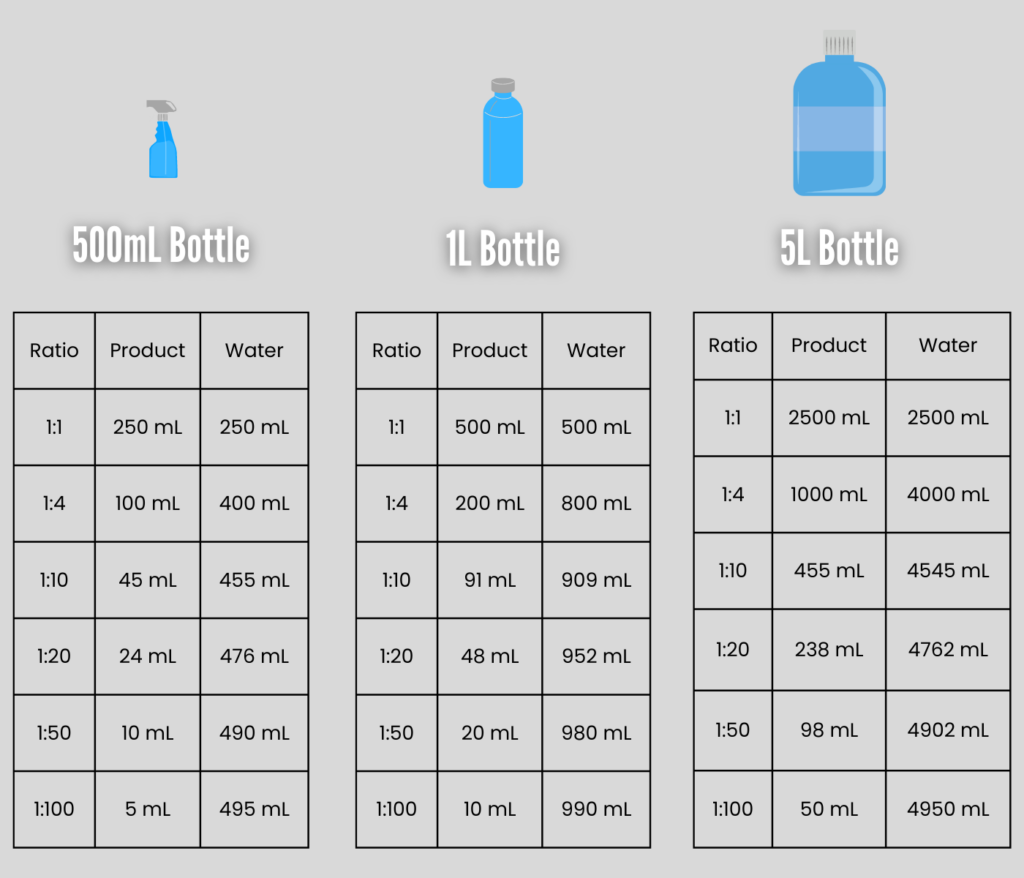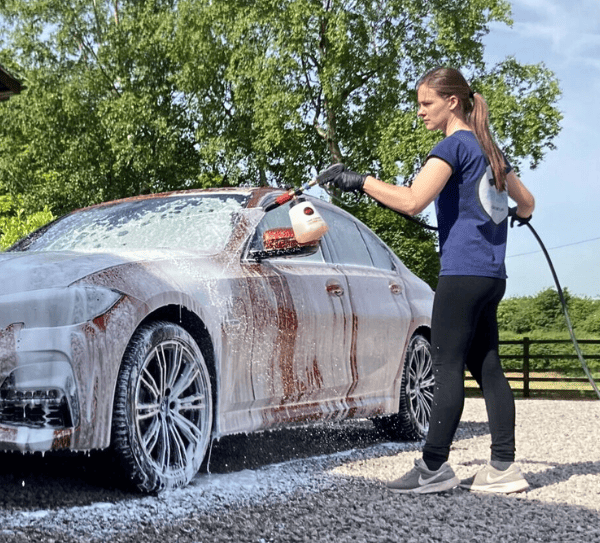Many car cleaning chemicals need to be diluted in order to make sure they are the right concentration to work effectively and safely. In this article I’ll clearly explain these ratios and give exact measurements needed for different amounts so you don’t need to do any calculations.
Don’t forget to save this post in your favourites so you can easily find it again.
Manufactures can often state the required dilution in different forms e.g. ratio, percentage, etc. So I’ve split this article into different sections so you can find what you’re looking for. I will also provide imperial (oz.) and metric (mL) measurements in each section.

Here are Amazon links to some useful measuring accessories.
This section contains product affiliate links. We may receive a commission if you make a purchase after clicking on one of these links.
Dilution Ratios e.g. 1:10
Most wheel cleaners, pre-washes and all-purpose cleaners will state the required dilution on the back of the bottle as a ratio e.g. 1:10. Another way of stating this dilution ratio is to say “1 part of product to 10 parts of water”.
Some manufacturers will swap the numbers around and say 10:1 instead of 1:10. In almost every case, the smaller number refers to the amount of product needed, and the larger number refers to the amount of water.
Here are some charts showing the most common dilution ratios and volumes and how much product you need to dilute in water. Simply click the dropdowns to see the amounts required for each volume. I have separated this into millilitres/ litres and fluid oz/ gallons.
To make 500 mL of solution
| Dilution Ratio | Amount of Product Needed | Amount of Water Needed |
| 1:1 | 250 mL | 250 mL |
| 1:4 | 100 mL | 400 mL |
| 1:10 | 45 mL | 455 mL |
| 1:15 | 31 mL | 469 mL |
| 1:20 | 24 mL | 476 mL |
| 1:50 | 10 mL | 490 mL |
| 1:100 | 5 mL | 495 mL |
To make 1000 mL (1 litre) of solution
| Dilution Ratio | Amount of Product Needed | Amount of Water Needed |
| 1:1 | 500 mL | 500 mL |
| 1:4 | 200 mL | 800 mL |
| 1:10 | 91 mL | 909 mL |
| 1:15 | 63 mL | 937 mL |
| 1:20 | 48 mL | 952 mL |
| 1:50 | 20 mL | 980 mL |
| 1:100 | 10 mL | 990 mL |
To make 5000 mL (5 litres) of solution
| Dilution Ratio | Amount of Product Needed | Amount of Water Needed |
| 1:1 | 2500 mL | 2500 mL |
| 1:4 | 1000 mL | 4000 mL |
| 1:10 | 455 mL | 4545 mL |
| 1:15 | 313 mL | 4687 mL |
| 1:20 | 238 mL | 4762 mL |
| 1:50 | 98 mL | 4902 mL |
| 1:100 | 50 mL | 4950 mL |
To make 16 oz of solution
| Dilution Ratio | Amount of Product Needed | Amount of Water Needed |
| 1:1 | 8 oz | 8 oz |
| 1:4 | 3.2 oz | 12.8 oz |
| 1:10 | 1.45 oz | 14.55 oz |
| 1:15 | 1 oz | 15 oz |
| 1:20 | 0.76 oz | 15.24 oz |
| 1:50 | 0.31 oz | 15.69 oz |
| 1:100 | 0.16 oz | 15.84 oz |
To make 32 oz of solution
| Dilution Ratio | Amount of Product Needed | Amount of Water Needed |
| 1:1 | 16 oz | 16 oz |
| 1:4 | 6.4 oz | 25.6 oz |
| 1:10 | 2.9 oz | 29.1 oz |
| 1:15 | 2 oz | 30 oz |
| 1:20 | 1.5 oz | 30.5 oz |
| 1:50 | 0.6 oz | 31.7 oz |
| 1:100 | 0.3 oz | 31.7 oz |
To make 1 gallon of solution
| Dilution Ratio | Amount of Product Needed | Amount of Water Needed |
| 1:1 | 66.6 oz | 66.6 oz |
| 1:4 | 26.7 oz | 106.6 oz |
| 1:10 | 12.1 oz | 121.1 oz |
| 1:15 | 83.3 oz | 124.9 oz |
| 1:20 | 6.3 oz | 126.9 oz |
| 1:50 | 2.6 oz | 130.6 oz |
| 1:100 | 1.3 oz | 131.9 oz |
How to Calculate Dilution Ratios
I’ll use an example to demonstrate.
- Work out how much total solution you want to make. For this example, I’ll say 500 mL of total solution.
- Find out the recommended dilution ratio for the product (this is usually on the back of the bottle). For this example, I’ll go with a 1:15 dilution.
- Work out the total number of parts needed to calculate. For this example, it’s 16 parts (1+15).
- Divide the total volume of solution by the number of parts. In this example, it’s 500 mL of solution divided by 16 parts = 31.25 mL. This gives us the amount that each part is worth.
- In this dilution, 15 parts of water are needed and 1 part of product. 15 parts of water = 31.25 mL x 15 = 468.75 mL
- In this dilution, 1 part of product is needed = 31.25 mL
- So in order to make a 500 mL solution at a 1:15 ratio you will need 468.75 mL of water and 31.25 mL of product
Percentages
It’s less common, but some manufacturers will state the required dilution for a product as a percentage.
This is different to “panel impact ratio” which is sometimes used for snow foams, and instead is just for chemicals like wheel cleaners, APCs and pre-washes. I’ll go through panel impact ratio in the next section of this article.
Here are some charts showing the most common dilution percentages and volumes, and how much product you need to dilute in water. Simply click the dropdowns to see the amounts required for each volume. I have separated this into millilitres/ litres and fluid oz/ gallons.
To make 500 mL of solution
| Percentage | Amount of Product Needed | Amount of Water Needed |
| 1% | 5 mL | 495 mL |
| 2% | 10 mL | 480 mL |
| 5% | 25 mL | 475 mL |
| 10% | 50 mL | 450 mL |
| 20% | 100 mL | 400 mL |
| 50% | 250 mL | 250 mL |
To make 1000 mL (1 litre) of solution
| Percentage | Amount of Product Needed | Amount of Water Needed |
| 1% | 10 mL | 990 mL |
| 2% | 20 mL | 980 mL |
| 5% | 50 mL | 950 mL |
| 10% | 100 mL | 900 mL |
| 20% | 200 mL | 800 mL |
| 50% | 500 mL | 500 mL |
To make 5000 mL (5 litres) of solution
| Percentage | Amount of Product Needed | Amount of Water Needed |
| 1% | 50 mL | 4950 mL |
| 2% | 100 mL | 4800 mL |
| 5% | 250 mL | 4750 mL |
| 10% | 500 mL | 4500 mL |
| 20% | 1000 mL | 4000 mL |
| 50% | 2500 mL | 2500 mL |
To make 16 oz of solution
| Dilution Ratio | Amount of Product Needed | Amount of Water Needed |
| 1% | 0.16 oz | 15.84 oz |
| 2% | 0.32 oz | 15.68 oz |
| 5% | 0.8 oz | 15.2 oz |
| 10% | 1.6 oz | 14.4 oz |
| 20% | 3.2 oz | 12.8 oz |
| 50% | 8 oz | 8 oz |
To make 32 oz of solution
| Dilution Ratio | Amount of Product Needed | Amount of Water Needed |
| 1% | 0.32 oz | 31.68 oz |
| 2% | 0.64 oz | 31.36 oz |
| 5% | 1.6 oz | 30.4 oz |
| 10% | 3.2 oz | 28.8 oz |
| 20% | 6.4 oz | 25.6 oz |
| 50% | 16 oz | 16 oz |
To make 1 gallon of solution
| Dilution Ratio | Amount of Product Needed | Amount of Water Needed |
| 1% | 1.3 oz | 131.9 oz |
| 2% | 2.7 oz | 130.6 oz |
| 5% | 6.7 oz | 126.6 oz |
| 10% | 13.3 oz | 119.9 oz |
| 20% | 26.7 oz | 106.6 oz |
| 50% | 66.6 oz | 66.6 oz |
How to Calculate Dilution Percentages
I’ll use an example to demonstrate.
- Work out how much total solution you want to make. For this example, I’ll say 500 mL of total solution.
- Find out the recommended dilution ratio for the product (this is usually on the back of the bottle). For this example, I’ll go with a 4% dilution.
- Divide 500 mL by 100 = 5 mL
- Multiply this number by the percentage required e.g. 5 mL x 4 = 20 mL. This is the amount of product needed.
- Calculate the amount of water needed by subtracting the amount of product needed from the total volume of solution required e.g. 500 mL – 20 mL = 480 mL
- So in order to make a 500 mL solution which has a 5% concentration of product, you will need 480 mL of water and 20 mL of product
Panel Impact Ratio
Panel impact ratio, more commonly referred to as “PIR” is sometimes used by manufacturers to indicate the required dilution ratio for snow foams or traffic film removers which are applied using a foam lance.
Panel impact ratio does not refer to the amount that you should put in your foam cannon, but the concentration that ends up actually touching the car.
The reason some manufacturers do this, is because the pressure washer dilutes the snow foam that you put in foam cannon when it is applied to the car. The amount it dilutes the solution by depends on the foam cannon and pressure washer you are using.
By factoring in this dilution, you can achieve a more accurate concentration of chemical that actually ends up on the car by removing the variable created by different pressure washer setups.
How to Calculate Panel Impact Ratio
- Fill your snow foam cannon with water. Make a note of this capacity.
- Turn your pressure washer on and dispense the cannon filled with water into a bucket.
- Measure how much water was dispensed in the bucket.
- Calculate the desired PIR by calculating the percentage of how much water was dispensed in step #3
Example
- The foam cannon has a maximum capacity of 1 litre.
- When dispensed, 10 litres (10,000 mL) of water was collected in the bucket.
- If you want say a 4% PIR, calculate 4% of 15 litres =((10,000/100) x4) = 400 mL
- This is the amount of snow foam you need to add to your foam cannon to achieve a 4% PIR. The rest (600 mL) can be topped up with water to fill the maximum 1 litre capacity.
If you’re struggling to work this out, then here’s a link to a Google Sheets calculator I’ve made so you can plug in the numbers and the formulas will work out how much water and snow foam you need to add to your cannon.
It works for both mL and oz, just make sure you use the same unit throughout.
PIR Calculator on Google Sheets
Looking for some good detailing products? Check out my recommended products page with all my favourite chemicals, equipment and accessories.


Hi Heather,
I’m a complete newbie when it comes to detailing but I’m looking for the dilution ratio for when i need to wipe off the panels after polishing?
I watched forensic detailing video a few years old and for a 1 lt.soray bottle,he used 680ml water and 300 ml of IPA?